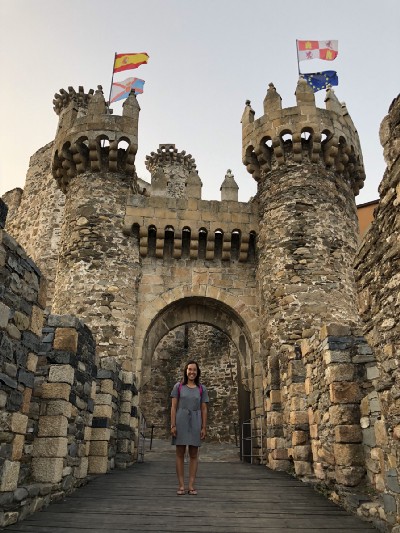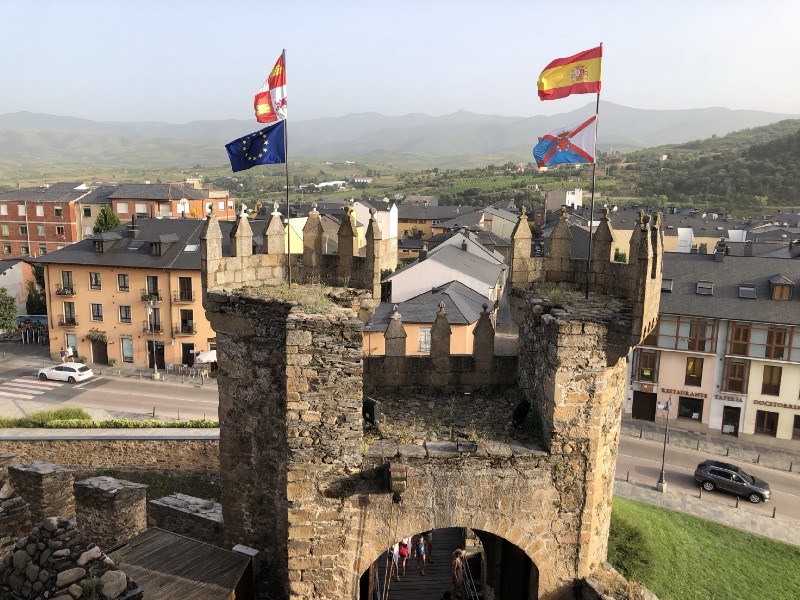Going slow on the Camino
Dear friends,
Today is my last day on the Camino for now. On day 40, I pause my journey in Ponferrada, a town guarded by a towering stone castle and bordered by mountains. It is lively here in this mountain town, and I can imagine the knights of old riding around on horseback, the faithful taking refuge in the many churches and cathedrals.
In the traditional sense, I have fallen 210 kilometers short of the goal, the city of Santiago. It is there that the body of Saint James is said to rest: Catholic pilgrims make the journey to honor this man and to atone for their sins. With mixed feelings of sorrow, disappointment, and joy, I accept that my journey will not end in this way.
Instead, tomorrow I take a train to Madrid; on Thursday, a plane to Tel Aviv; on Sunday, a bus to Jerusalem.
In Jerusalem, I will help a friend facilitate a children’s summer camp and sangha. My heart is fully committed to this path, and I touch curiosity and joy when I imagine sharing my love of mindfulness and play.
And yet sorrow remains too.
Celebrating the choice to go slowly
On this last day, in the shadow of mountains, I celebrate the peace in going slow.
To go slow is to surrender to the needs of the body, to tread gently on jagged rocks and twisted roots. It is to be fully present with each step, to let go of the impatience that says we must be at this place at this time. To go slow is to let go of any place but this one, any person but the one beside you. It is to steady the mind, to open the heart, and to listen with a curious ear.
To go slow is not about how quickly you walk or how far you travel in one day. In practice, it is to avoid setting a destination for the day entirely, to let the day unravel moment by moment. It is the practice of aimlessness, a practice that I embraced on this Camino journey.
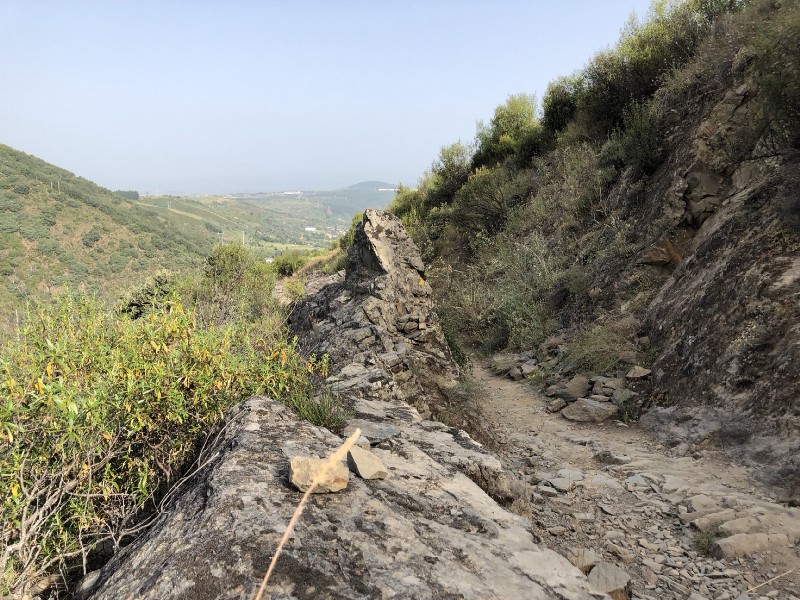
The practice of aimlessness
When I started this Camino on June 28 in Saint-Jean-Pied-de-Port, I did not adopt Santiago as my goal.
My intention was to remove any pressure on my body to move quickly, and to ease my mind from pushing. I did not want to turn the Camino into another item on the to-do list, with towns that had to be reached on certain days.
I wanted to go slowly, to respond to my body with immediacy, and to let the days unravel spontaneously. I took joy in my slowness, even adapting the snail as my trail mascot. To be slow is to have nowhere to go! I often delighted in this practice of aimlessness.
Letting each day unfold without making plans
My Camino unfolded in a beautiful and delicate way; each day I woke up without an alarm to the sounds of birds chirping and pilgrims packing. I would eat a banana and bread with jam, and start walking. When I felt hungry, I’d stop for tea and Spanish tortilla (delicious egg and potato pie), settle down with a friend for a quick chat, and then walk until lunch.
If I encountered good company at lunch, I might tell stories until the afternoon. Maybe I’d stay in that town, or walk with someone ‘til the next one, or go on until I found something curious. Then I’d look for an alburgue with a garden, check in, shower, and hand wash my laundry. It’d be early afternoon by then, siesta time in Spain, and the entire town would be sleeping. I’d follow suit: resting, napping, writing in my journal, daydreaming.
When the town awoke at 5pm, I’d venture outdoors to walk around, snack on tapas, and look for dinner. Dinner would be simple, a pilgrim’s menu of roasted chicken, salad, French fries, maybe macaroni with chorizo (I stopped being a vegetarian on Camino day 2 when my body craved protein and there was no tofu in sight). And then I’d write, talk, and relax until bed around 9:30 or 10pm.
Sometimes, all of these things happened; other times, few. Such was the practice of aimlessness for me on this Camino.
To go slow requires practice
To go slow is to practice listening and allowing. On day 2, I walked through lush forest and small villages on the path from Roncesvalles to Zubiri. In each step, my left knee was in severe pain, and I pushed through the pain to keep pace with my three friends.
In early afternoon, as we descended into the village of Bizkarretz, my body again asked to rest. I conceded: to continue on was to risk more serious injury, and I did not have the mental energy to keep pushing. In that small village, my whole body exuded gratitude for stopping. I had time for laundry, nursing my feet, and showering without hurry — one deep exhale for body and mind.
To stop requires practice: this first decision to rest after 12 kilometers (instead of pushing to Zubiri) made it easier to listen and respond the next day I experienced pain. And over time, I learned to stop not just out of pain, but out of curiosity and intuition.
To go slow is to satisfy the body’s basic needs
It is difficult to walk without aim if the body requires water or food, has to use the toilet, or is without energy. To go slow, meeting my basic needs is a prerequisite; otherwise, I will hurry to my next destination every time.
To go slow is to allow for intuition and curiosity
A friend and I stopped in the birthplace of Santo Domingo for lunch at a quiet alburgue. The hospitalera (caretaker of pilgrims and property) greeted us warmly, made my sandwich by donation, and took time to make sure we were cared for. When I stepped outside with a full stomach, one raindrop hit my arm and I saw a friendly German man sitting on a bench. He asked if the alburgue was open, I replied that it was: within minutes I was back requesting a bed and within an hour a thunderstorm raged. I can’t explain what made me stop, just the contented feeling of a good lunch, generous host, and my curiosity about the man.
I’ve stopped many more times like this, simply because I meet someone I like or see an alburgue with a peaceful garden. Without a destination for the day or a person to keep pace with, I am free to decide in the moment where to stop. This practice invites freedom into my bones, teaches my body that it is free to decide when to rest.
To go slow invites in wonder and joy
One of my favorite days on the Camino was the way from Villar de Mazarife to Santo Justo de la Vega. I woke up without hurry, but the sun was strong and I walked the first ten kilometers grumbling, hot, and simply wanting to arrive. And then very deliberately, I chose to slow down. Over fresh orange juice, black tea, and a crossiant with salami, I befriended the other pilgrims sitting outside. I sat for over an hour telling stories and making new friends, and when I stood up to walk, I was refreshed and ready to go slow.
The sky was incredible that day: crisp white clouds floating with white cloud backdrops, royal blue sky and more clouds that seemed to cascade forever. To go slow was to delight in the sky.
I passed through Hospital de Órbiga, a town of character and charm situated on the edge of a river. On other days, I may have stopped; that day, my body wanted to continue its dance among the clouds. I marveled and danced and sang, each step a meditation on the glory of nature. The heat of the morning was forgotten, and I never wanted to stop walking.
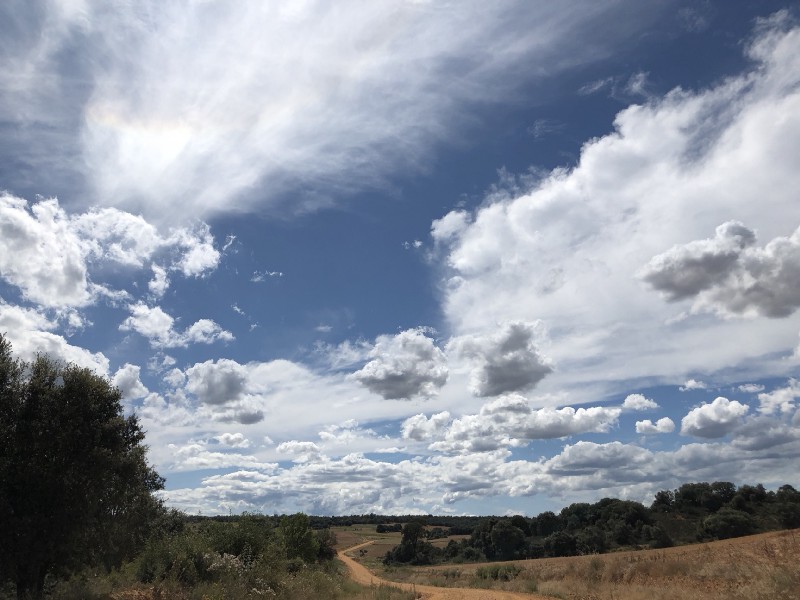
At six, I arrived at San Justo de la Vega, which consisted of a garden and truck with fruits for donation. David’s Place. I saw the Iranian biker Ale there and he smiled. I stopped for one hour and then another, eating watermelon, bread, crackers with jam. I wrote a song.
In the evening haze, after all the pilgrims on foot and bike had passed for the day, six of us remained: Ale from Iran, Djamal from France, Giulia from Italy, Marco from Italy, Francisco from France, and me.
Ale recited poetry from Rumi and Hafez, I sang the song I had written moments before, Djamal played an instrument akin to a digiridoo. I learned that Francisco was a writer of philosophy and Giulia worked in restaurants in Venice.
As the sun set behind the hills, we played music together. Giulia and Djamal collaborated on the guitar, one string each, Ale and Francisco and I played rhythms on old pans we found in the yard. I danced. There was no other place to go, no other people to be with. I was completely present and alive with the beauty of the moment: six strangers together in sacred space.
At night, we slept outside with views of the starry sky; in the morning, we nourished our bodies with fruit and the joy of being together.
This place and these friends were the gift of a day walked slowly. On another day, I may have passed that fruit stand and marched on to the big city of Astorga. But this day, having danced with the clouds for hours, I was not in a hurry. I stopped for a moment to rest and share fruit, and found peace with new friends.
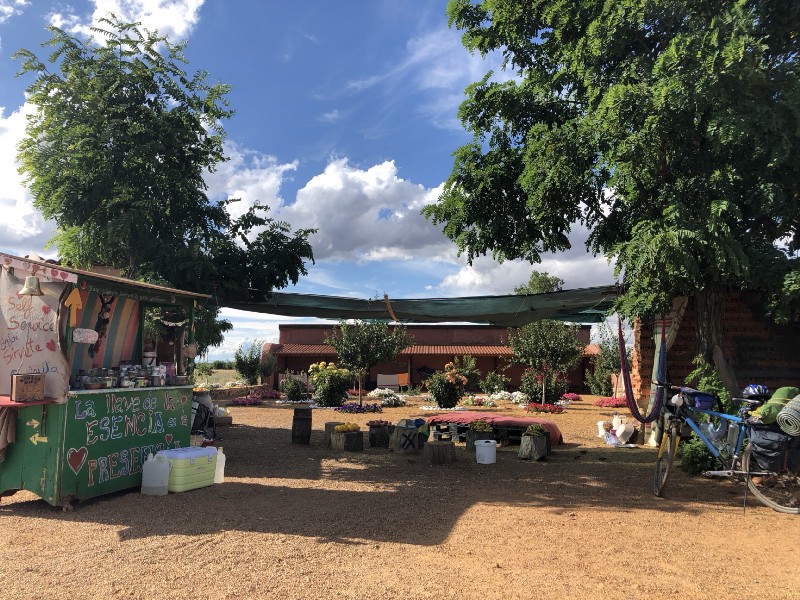
Somewhere to be
Oh, the irony! I paused on the trail for two hours to write this essay about aimlessness, and now I find myself five kilometers from Ponferrada with two hours before a scheduled call with my dear friend Malena.
For twenty minutes of walking through Molineseca suburbs, I am unhappy, sinking in the heat and the hard cement. I pause in the shade of a tree and gratitude arrives.
How often do we have true aimlessness in non-Camino life? There are so rarely perfect conditions without anywhere to go or anything to do. And thus this moment is a gift, an opportunity to practice spaciousness in the midst of scheduled life.
How can I create spaciousness when there is somewhere to be?
In the shade, I remember that I have freedom of choice: I can reschedule the call with Malena, stop in Molineseca and hike the last five kilometers tomorrow morning, or I can walk at a quick pace into the big city. My preference is to walk quickly, because I want to see the castle in Ponferrada tonight and I want to prioritize my commitment to my dharma friend.
To go slowly with somewhere to be: I start by reminding myself that I can always stop if my body is in pain or to address one of my basic needs. Outside of that, I forgo my normal photo-taking and wandering pace, and simply focus on walking. I walk in long strides from shade to shade, drinking water as I go.
After thirty minutes, I check how far I have to go, reassess my options (stopping early to chat, going to an alburgue outside the city) and decide that my current path is still preferable.
Inhaling deeply, I remind myself that my quick pace is a choice; I am walking in this way to be on time to talk with Malena and to see the castle in town before I leave. And there is freedom in this choice.
Could I have set Santiago as a goal while allowing space for spontaneity?
Perhaps, yes — by letting go of my attachment to wandering, taking fewer rest days, by sticking to a schedule. In this moment, I’m glad that I didn’t choose this middle path: for navigating a schedule takes energy and focus.
In contrast, I enjoyed resting in aimlessness. Santiago will be there when and if I choose to I return.
Saying goodbye to the Camino
I arrived to the San Nicolás del Flüe alburgue in Ponferrada with enough time to check in, unpack, charge my dead phone, and shower — all that’s needed for my body to reset — before my call with Malena.
And then comes the visit to the castle, the biggest monument of Ponferrada in a town filled with churches. The castle was originally built by the Knights of Templar, and two palace structures are guarded closely by vast castle walls. I walk the walls slowly, and eventually reach the top of a tower overlooking the town and castle interior. There, I lay down to rest.
Rest, my dear Melanie.Focus on your breath and the calm of the setting sun. There is nowhere further to go for now.
My rest is interrupted by the two castle tour guides. Está cerrado. Closing time.
My Camino ends here for now, in this upper tower in the castle of Ponferrada. It is time to go, for Jerusalem awaits.
